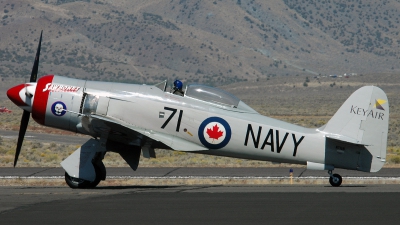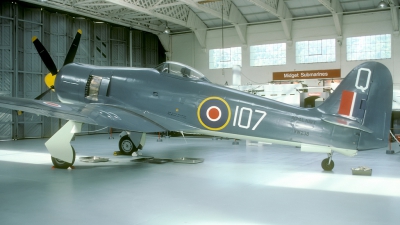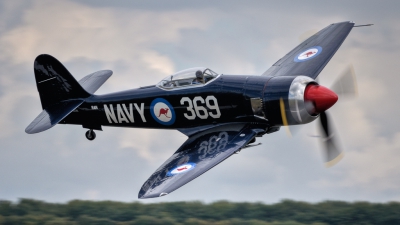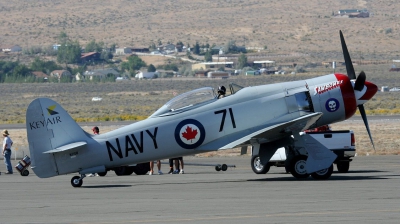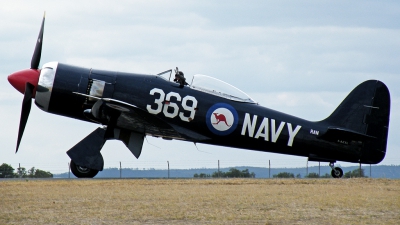Hawker Fury ISS Aircraft Data
With the end of World War II in sight, the Royal Air Force no longer had a requirement for Hawker's design to meet Specification F.2/43 (initially known as the Tempest Light Fighter) and therefore the order for the production of 200 Fury I (Fury F.1) aircraft was cancelled. (These aircraft for the RAF would have been serialled TF620 to TF667 and TF681 to TF876).
The Iraqi Government however expressed interest in the Fury and, on 4 December 1946, placed an order for 30 single-seat fighter and four dual-seat trainer aircraft. At that time no two-seat trainer/conversion had been envisaged by Hawkers.
The thirty single-seat fighters were similar in design to the RAF Fury. The aircaft were powered by a Bristol Centaurus XVIII driving a five-bladed Rotol propeller. These 30 machines, designated Fury Iraqi Single Seat (ISS), with 'construction numbers' from 1 to 30 (in most sources presented as 'ISS-1' and so on), became known as 'The Baghdad Furies'. The aircraft were serialled 231 to 260. All aircraft were produced at Kingston factory. Final assembly and test flying occurred at the Hawker airfield of Langley near Slough, a few miles to the northwest of what is now Heathrow Airport.
The aircraft were finished in an RAF desert scheme consisting of two colours, Mid-Stone and Dark Earth, whilst the under surfaces were painted Azure Blue. The spinner caps were probably also in Azure Blue, although Dark Earth or Mid-Stone seemed more likely.
First Furies to Iraq.
The first nine aircraft, serialled 231 to 237 with 239 as well as dual-seat 261, were flown to Iraq in the early months of 1948, the delivery date quoted for this first batch is 24 February, 1948. The first Royal Iraqi Air Force unit to receive the new machines was No. 7 Squadron at Al-Rashid Air Base, Baghdad. At that time the unit was flying Avro Anson bombers, detached to Mafraq Air Base, in Transjordan, as part of the Arab coalition forces of the Arab League in the first Arab-Israeli War. (Mafraq is now King Hussain Air Base, Jordan).
A number of the unit's Anson pilots, as well as some from No.1 Squadron, were summoned to return to Al-Rashid for conversion to the Fury. With the pressing need to return Fury pilots as quickly as possible to operational war duties, it was inevitable for accidents to happen. The first fatal crash of a Fury occured on 7 June 1948, killing Captain Yahya Dunini of No.1 Squadron.
Iraqi Furies in action.
Throughout the First Arab-Israeli War (15 May 1948 - 10 March 1949), the Furies of the Royal Iraqi Air Force were engaged in military operations, although, their pilots were at the time relatively inexperienced in the operation of high performance fighters, as well as the fact, that the supply of ammunition was severely restricted by the politics of the day. The Iraqi Air Force had no stocks of cannon ammunition as had, for example the Egyptian Air Force, having operated cannon armed Spitfires and Hurricanes.
By the time decision was taken to move the Furies of No.7 Squadron to Amman, in Transjordan, from where these were to participate in the war against Israel, only about six the fourteen aircraft delivered up to the first half of July were operational. On 18 July 1948, the Furies departed for Amman, only to re-deploy the following day, 19 July 1948, to Mezzeh airfield (now Al-Mazzeh Air Base), Damascus, in Syria, to fly their first combat sorties. These included an armed reconnaissance over the Israeli port of Haifa and the airfields of Ramat David, southeast of Haifa, and Sde Dov (Dov Hoz) near Tel Aviv by two Furies. The destruction of an Israeli B-17 was claimed by the Iraqi pilots. Later that day an armistice would come into force.
On 19 November 1948, an Iraq Fury was sighted by Israeli intelligence at Mezzeh, Damascus, although it is not clear whether this was one of the aircraft damaged on landing earlier in the summer or a new aircraft for boosting the city's defence against the feared Israeli B-17 Flying Fortresses. In early December, four 'Baghdad Furies' deployed to Mezzeh to assist in the air defence of the Syrian capital.
Earlier, on 25 September 1948, No.1 Squadron, having received their first Furies, had been relocated from Mosul to Baghdad's Al-Rashid for the same reason. The squadron had become operational at Habbaniyah Air Base some time after the first Iraqi Fury unit, No.7 Squadron.
Transfer to Egypt.
Shortly after 19 July 1948, four of the remaining operational Furies of No.7 Squadron were transferred (on loan) to the Egypt Air Force, while the Iraqi pilots returned to their native country. On landing at Almaza Air Base,in the eastern outskirts of Cairo, one Fury was damaged. The other three aircraft took up residence at the Cairo base and El Arish airfield, the latter located some 40 kilometres to the southwest of the Gaza Strip border.
The Furies retained their Iraqi identification marks, but (some) received black and white identification stripes on the outer wing sections. The large Iraqi Air Force large serial numbers on the fuselage, to the rear of the triangular Iraqi insignia, were overpainted in the 'Mid-Stone' colour. The serial number was relocated in substantially smaller numerals beneath the Iraqi Air Force triangle. Probably the serial was prefixed 'RIAF'.
One of the Egyptian pilots happened to be Tahir Zaki, who earlier that year had flown the F.2/43 Fury prototype NX798/G-AKRY. In April 1948 Hawker test pilot Bill Humble had demonstrated the aircraft during a sales tour to the country. On 24 April Humble displayed the Fury at Almaza Air Base. One of the Egyptian pilots invited to fly G-AKRY was Zaki. Then, on 27 April after Humble had made a short test flight in preparation of the return flight to the UK, he found the Fury had been moved from the civil side of the airfield to the military part. It turned out, the Fury had been impounded by the authorities and handed over to the Royal Egyptian Air Force. Some time later G-AKRY appeared in silver overall Egyptian Air Force colours, serialled '701'. Furthermore, they installed four 20mm cannon, taken from unserviceable Spitfire IXs, fitted armour plating to protect the pilot and had fitted underwing universal bomb carriers. Despite of the fact Hawkers were robbed of their aircraft, the British Government agreed in the sale of twelve Furies to Egypt.
In the last days of December 1948, at least two Furies were to see action against the Israeli Air Force. On 29 December Fury 237 had been flown from Almaza to El Arish. That same day 237 was scrambled, together with three Fiat G-55As, to intercept an Israeli B-17 escorted by two Spitfires on the way to their target, the Egyptian garrison at Al-Faluja, some 30 kilometres northeast of Gaza City. The outcome of the ensueing battle remains unclear as the Egyptian claimed three aircraft shot down. Probably only one of the Israeli aircraft received damage. The Israeli pilots claimed to have damaged two Egyptian aircraft.
The following day 237 flew two sorties from El Arish, shortly before the order was given to evacuatie the airfield, as Israeli forces had broken through Egyptian lines far beyond El Arish. All airworthy aircraft left their base in a haste and departed for Almaza, Cairo. From there Captain Mustafa Kamal Nasr took off in 235 in the early morning of 31 December 1948. He had been detailed on an armed reconnaissance over part of the Sinai. He did not return. The war would continue, but there is no further information on the involvement of the Iraqi Air Force Furies. The conflict ended officially on 10 March 1949.
Type designation.
The correct or most appropriate type designation of the Iraqi Air Force Furies has been, and in fact still is, subject to debate. For the time being, the 'Baghdad Furies' as the aircraft of the first Iraqi order became known in England, these aircraft will be referred to as Fury Iraqi Single Seat (ISS): 30 single-seat aircraft ordered on 4 December 1946 (ISS-1 to ISS-30 Iraqi Air Force serials 231 to 259) and delivered during 1948. These a/c featured the full-shaped rudder as on the Sea Fury F.X.
The first order also included four dual-seat aircraft. These were referred to as Iraqi Dual Seat or IDT. At Hawkers the temporary 'serial' IDT-1 was applied to the first aircraft. In Iraqi service IDT-1 received serial 261. Of the four aircraft, only two two-seaters were delivered, the other Iraqi machine being IDT-3, serial 263. IDT-2 was completed for the Pakistani Air Force as K850, whilst IDT-4 became the prototype for the Sea Fury T.20, serialled VX818.
The four Iraqi two-seaters were initially serialled 161 to 164, later reserialled 261 to 264.
The second Iraqi order, placed on 21 July 1951, called for 15 new aircraft, similar or based on the Sea Fury FB.11. These aircraft retained the FB.11 modified rudder, but lacking tail-hook and catapult attachment points. These Furies received serials 312 to 326. The second part of this order asked for another 10 refurbished and de-navalised ex-FAA Sea Fury FB.11s. These Furies were serialled 302 to 311. So in total 45 single-seat aircraft were built for the Iraqi Air Force, supplemented by the 10 second-hand FB.11s.
The Iraqi Air Force Fury inventory was completed with the arrival of three ex FAA T.20s. These machines received serials 327 to 329.
Preserved and airworthy Iraqi Air Force Fury ISS around the world.
The relatively large number of former Iraqi Air Force Furies around today can be attributed to the fact that in the 1970s warbird-enthusiasts and owners, Ed Jurist and David Tallichet (Military Aircraft Restoration Company) succeeded in obtaining at least 24 (but probably 27) of the surviving Iraqi Air Force Furies. In 1979, their 'holy grail' was shipped to Orlando, Florida, and stored for future restoration and onward sale. First aircraft of this shipment to fly again was Fury FB.11 310. The machine was restored to flying condition in Florida for owner John Williams and made her first flight on 13 July 1979. Sadly the Fury, in Royal Canadian Navy markings, crashed on 9 October 1981 at the Confederate Air Force Airsho'81 at Harlingen, Texas, killing Williams.
The year before, in 1980, Australians Guido Zuccoli and Rob Poynton, had obtained four Furies from the Orlando-batch: ISS-13 (IAF serial 243), ISS-19 (IAF serial 249), ISS-23 (IAF serial 253) as well as Fury FB.11 IAF serial 303 (ex Fleet Air Arm WJ298). Rob Poynton's aircraft, ISS-19, became VH-HFR, later reregistered VH-ISS and airworthy in her Iraqi c/s. Today this aircraft is airworthy in Belgium as OO-ISS. The three Zuccoli Furies, IAF serial 303, ISS-13 and ISS-23 respectively became VH-HFG, VH-HFX and VH-HFA. VH-HFX was sold to the Old Flying Machine Company (OFMC) at Duxford. VH-HFA was exported to the US in late 1988. Guido Zuccoli's VH-HFG went back to the US as N97SF, before being exported to Germany and is now registered D-CRZY with Stefano Landi in Itali.
Listed below are the (potentially) airworthy ISS aircraft, followed by those of which their current status is not kwown or confirmed. Finally listed, for completeness, are the preserved and/or airworthy former Iraqi Fury FB.11s :
ISS-19 Iraqi Air Force 249, c/n 37731
Airworthy in Belgium, registered OO-ISS in Iraqi Air Force colours as '249'.
Ex N54SF; ex VH-HFR and VH-ISS.
ISS-20 Iraqi Air Force 250, c/n 37514
Airworthy at Avignon-Caumont Apt., France, registered F-AZXL. This Fury is in a RAN c/s coded '369'.
Ex N21SF; The Fury spent som years (from 2001 to 2008) in South Africa with Stu Davidson, registered ZU-WOW.
ISS-23 Iraqi Air Force 253, c/n 37703 (but also quoted as 37702)
Ex N40SF; ex VH-HFA. Airworthy with John McGuire/War Eagles Museum, Santa Teresa, New Mexico, USA, registered N57JB 'Magnificent Obsession'. Type in the FAA-Register is 'Sea Fury Mk.10'.
ISS-24 Iraqi Air Force 254, c/n 37537
N35SF. Airworthy with KFG Aviation LLC, Huntersville, North Carolina, USA in 2020. This Fury is listed in the FAA-Register as a 'Sea Fury T.20' and is powered by a Wright R-3350-26WD engine.
Current status of the following aircraft is not known/not confirmed:
ISS-11 Iraqi Air Force 241, c/n 87954
N63SF; The aircraft was initially stored with Vintage Aircraft International at Orlando, Florida, but later transported to Nyack, New York.
FAA-certicicate issued on 15 August 2018 for owner Eagle's Wings Aero LLC, Englewood, Colorado, USA. The aircraft's type in the FAA Register is given as 'Sea Fury T.20'. the Fury is powered by a P&W R-2800.
ISS-13 Iraqi Air Force 243, c/n 37534
Ex N28SF; VH-HFX and G-BTTA with the OFMC at Duxford. At Duxford the Fury appeared in a pseudo Dutch Navy c/s, coded '115'. She also represented Fleet Air Arm Fury 'VW238/Q-107' of 802 Squadron aboard HMS Vengeance in 1948. Sold in France in 2012; Current status?
ISS-22 Iraqi Air Force 252, c/n 37727
Ex N48SF; to N48SG. Current status?
ISS-25 Iraqi Air Force 255, c/n 37536
Ex N34SF; ex N666HP; N13HP reserved on 20 March 2018 as 'Sea Fury ISS-25'; This Fury is powered by a Wright R-3350-34 91. Current status?
ISS-28 Iraqi Air Force 258, c/n ?
Noted as decoy at Shaibah AB, Basra in 2003. No other information after this date.
Preserved and airworthy Iraqi Air Force Fury FB.11 around the world.
Iraqi Air Force 302, c/n 37542
Ex FAA WJ293; Airworthy with John Shackleford, Roanoke, Texas, USA, in 2020. Registered N39SF as a 'Sea Fury T.20' with a Wright R-3350 series engine.
Iraqi Air Force 303, c/n 37522
Ex FAA WJ298; Ex N26SF; Ex VH-HFG; N97SF; Airworthy in Italy with Stefano Landi, registered D-CRZY.
Iraqi Air Force 304, c/n 37721
Ex FAA WM483; Airworthy with International Air Services Inc., NV, USA in 2020, registered N42SF as a 'Sea Fury T.20', with a Wright R-3350-32WA engine.
Iraqi Air Force 305, c/n 37755
Ex FAA WM484; Offered for sale in the US by Courtesy Aircraft in 2021, but in an unrestored state. Registered N59SF as 'Sea Fury T.20'.
Iraqi Air Force 308, c/n 37729 (also quoted as 37757 and 41H/65816)
Ex FAA WN480; N60SF; With the Fighter Factory, Virginia Beach, Virginia, USA, registered N60SF as 'Sea Fury Mk.11'. 'Simply Magnificent'.
Iraqi Air Force 310, c/n 37528
Ex FAA WN482; Registered N19SF; First flew on 13 July 1979. Crashed at Harlingen, Texas on 9 October 1981. Parts and identity used in a new rebuild project by Sanders Aircraft Inc, also using parts of a former RCN Sea Fury. This new machine, powered by a Wright R-3350-42 was also registered N19SF for Sanders Aircraft Inc, Ione, California and made her first flight on 30 July 1994.
Iraqi Air Force 312, c/n 37724
Under Restoration to airworthy status by Sonoma Valley Aircraft Inc., California. Registered N45SF as Sea Fury T.20.
Iraqi Air Force 313, cn 37517
Airworthy in 2020 with J. Stewart Dawson, McKinney, TX, USA, registered N24SF as Sea Fury FB.11. 'Spirit of Texas' is powered by a Wright R-3350-32WA.
Iraqi Air Force 314, c/n 37541
N38SF; With DB Aero Inc, Wilmington, Delaware. Current status?
Iraqi Air Force 315, c/n 37539
Airworthy in the UK with Anglia Restorations at Sywell, registered G-CBEL in the colours of the first 'Naval Fury' prototype 'SR661'.
Iraqi Air Force 316, c/n 37733
Ex N56SF; Exported to France in 2010. Airworthy in France, registered F-AZXJ in a RAN c/s as 'WH589/NW-115'.
F-AZXJ was initially re-engined with a Wright R-3350, which suffered failure at the 2015 Duxford Flying Legends Air Show.
'XJ' flew again in March 2016, now fitted with a Pratt&Whitney R-2800. In early 2022 the aircraft was reported sold to a new owner.
Iraqi Air Force 318, c/n 37726
N46SF, registered to DB Aero Inc, Wilmington, Delaware; Current status?
Iraqi Air Force 324, c/n 37734 (also given as 41H/623271)
N58SF, entered in the FAA Register as a 'Baghdad Fury DT Mk.II'(!) with Kermit Weeks at Polk City, Florida. Registration N58SF was cancelled on 6 April 2012; Current status?
Iraqi Air Force 325, c/n 37725 (also given as 41H/656823)
Ex N30SF; 'Skyfury'/'Southern Cross', N71GB, Airworthy with Sawbones Air LLC, Blaine, Minnesota, USA in 2020.
(Parts of) airframes of T.20 VZ365 and IraqiAF 325/N30SF, being used in rebuild into a 'Skyfury', a Sea Fury airframe with a Wright R-3350-26WD Skyraider engine and propeller. N71GB is registered as a 'Sea Fury FB.11'.
Iraqi Air Force 326, c/n 37723 (also given as 41H/643827)
N43SF was registered as a 'Sea Fury T.20'; Reportedly shipped to the UK in 2020 for restoration to airworthyness; Current status?
The Iraqi Government however expressed interest in the Fury and, on 4 December 1946, placed an order for 30 single-seat fighter and four dual-seat trainer aircraft. At that time no two-seat trainer/conversion had been envisaged by Hawkers.
The thirty single-seat fighters were similar in design to the RAF Fury. The aircaft were powered by a Bristol Centaurus XVIII driving a five-bladed Rotol propeller. These 30 machines, designated Fury Iraqi Single Seat (ISS), with 'construction numbers' from 1 to 30 (in most sources presented as 'ISS-1' and so on), became known as 'The Baghdad Furies'. The aircraft were serialled 231 to 260. All aircraft were produced at Kingston factory. Final assembly and test flying occurred at the Hawker airfield of Langley near Slough, a few miles to the northwest of what is now Heathrow Airport.
The aircraft were finished in an RAF desert scheme consisting of two colours, Mid-Stone and Dark Earth, whilst the under surfaces were painted Azure Blue. The spinner caps were probably also in Azure Blue, although Dark Earth or Mid-Stone seemed more likely.
First Furies to Iraq.
The first nine aircraft, serialled 231 to 237 with 239 as well as dual-seat 261, were flown to Iraq in the early months of 1948, the delivery date quoted for this first batch is 24 February, 1948. The first Royal Iraqi Air Force unit to receive the new machines was No. 7 Squadron at Al-Rashid Air Base, Baghdad. At that time the unit was flying Avro Anson bombers, detached to Mafraq Air Base, in Transjordan, as part of the Arab coalition forces of the Arab League in the first Arab-Israeli War. (Mafraq is now King Hussain Air Base, Jordan).
A number of the unit's Anson pilots, as well as some from No.1 Squadron, were summoned to return to Al-Rashid for conversion to the Fury. With the pressing need to return Fury pilots as quickly as possible to operational war duties, it was inevitable for accidents to happen. The first fatal crash of a Fury occured on 7 June 1948, killing Captain Yahya Dunini of No.1 Squadron.
Iraqi Furies in action.
Throughout the First Arab-Israeli War (15 May 1948 - 10 March 1949), the Furies of the Royal Iraqi Air Force were engaged in military operations, although, their pilots were at the time relatively inexperienced in the operation of high performance fighters, as well as the fact, that the supply of ammunition was severely restricted by the politics of the day. The Iraqi Air Force had no stocks of cannon ammunition as had, for example the Egyptian Air Force, having operated cannon armed Spitfires and Hurricanes.
By the time decision was taken to move the Furies of No.7 Squadron to Amman, in Transjordan, from where these were to participate in the war against Israel, only about six the fourteen aircraft delivered up to the first half of July were operational. On 18 July 1948, the Furies departed for Amman, only to re-deploy the following day, 19 July 1948, to Mezzeh airfield (now Al-Mazzeh Air Base), Damascus, in Syria, to fly their first combat sorties. These included an armed reconnaissance over the Israeli port of Haifa and the airfields of Ramat David, southeast of Haifa, and Sde Dov (Dov Hoz) near Tel Aviv by two Furies. The destruction of an Israeli B-17 was claimed by the Iraqi pilots. Later that day an armistice would come into force.
On 19 November 1948, an Iraq Fury was sighted by Israeli intelligence at Mezzeh, Damascus, although it is not clear whether this was one of the aircraft damaged on landing earlier in the summer or a new aircraft for boosting the city's defence against the feared Israeli B-17 Flying Fortresses. In early December, four 'Baghdad Furies' deployed to Mezzeh to assist in the air defence of the Syrian capital.
Earlier, on 25 September 1948, No.1 Squadron, having received their first Furies, had been relocated from Mosul to Baghdad's Al-Rashid for the same reason. The squadron had become operational at Habbaniyah Air Base some time after the first Iraqi Fury unit, No.7 Squadron.
Transfer to Egypt.
Shortly after 19 July 1948, four of the remaining operational Furies of No.7 Squadron were transferred (on loan) to the Egypt Air Force, while the Iraqi pilots returned to their native country. On landing at Almaza Air Base,in the eastern outskirts of Cairo, one Fury was damaged. The other three aircraft took up residence at the Cairo base and El Arish airfield, the latter located some 40 kilometres to the southwest of the Gaza Strip border.
The Furies retained their Iraqi identification marks, but (some) received black and white identification stripes on the outer wing sections. The large Iraqi Air Force large serial numbers on the fuselage, to the rear of the triangular Iraqi insignia, were overpainted in the 'Mid-Stone' colour. The serial number was relocated in substantially smaller numerals beneath the Iraqi Air Force triangle. Probably the serial was prefixed 'RIAF'.
One of the Egyptian pilots happened to be Tahir Zaki, who earlier that year had flown the F.2/43 Fury prototype NX798/G-AKRY. In April 1948 Hawker test pilot Bill Humble had demonstrated the aircraft during a sales tour to the country. On 24 April Humble displayed the Fury at Almaza Air Base. One of the Egyptian pilots invited to fly G-AKRY was Zaki. Then, on 27 April after Humble had made a short test flight in preparation of the return flight to the UK, he found the Fury had been moved from the civil side of the airfield to the military part. It turned out, the Fury had been impounded by the authorities and handed over to the Royal Egyptian Air Force. Some time later G-AKRY appeared in silver overall Egyptian Air Force colours, serialled '701'. Furthermore, they installed four 20mm cannon, taken from unserviceable Spitfire IXs, fitted armour plating to protect the pilot and had fitted underwing universal bomb carriers. Despite of the fact Hawkers were robbed of their aircraft, the British Government agreed in the sale of twelve Furies to Egypt.
In the last days of December 1948, at least two Furies were to see action against the Israeli Air Force. On 29 December Fury 237 had been flown from Almaza to El Arish. That same day 237 was scrambled, together with three Fiat G-55As, to intercept an Israeli B-17 escorted by two Spitfires on the way to their target, the Egyptian garrison at Al-Faluja, some 30 kilometres northeast of Gaza City. The outcome of the ensueing battle remains unclear as the Egyptian claimed three aircraft shot down. Probably only one of the Israeli aircraft received damage. The Israeli pilots claimed to have damaged two Egyptian aircraft.
The following day 237 flew two sorties from El Arish, shortly before the order was given to evacuatie the airfield, as Israeli forces had broken through Egyptian lines far beyond El Arish. All airworthy aircraft left their base in a haste and departed for Almaza, Cairo. From there Captain Mustafa Kamal Nasr took off in 235 in the early morning of 31 December 1948. He had been detailed on an armed reconnaissance over part of the Sinai. He did not return. The war would continue, but there is no further information on the involvement of the Iraqi Air Force Furies. The conflict ended officially on 10 March 1949.
Type designation.
The correct or most appropriate type designation of the Iraqi Air Force Furies has been, and in fact still is, subject to debate. For the time being, the 'Baghdad Furies' as the aircraft of the first Iraqi order became known in England, these aircraft will be referred to as Fury Iraqi Single Seat (ISS): 30 single-seat aircraft ordered on 4 December 1946 (ISS-1 to ISS-30 Iraqi Air Force serials 231 to 259) and delivered during 1948. These a/c featured the full-shaped rudder as on the Sea Fury F.X.
The first order also included four dual-seat aircraft. These were referred to as Iraqi Dual Seat or IDT. At Hawkers the temporary 'serial' IDT-1 was applied to the first aircraft. In Iraqi service IDT-1 received serial 261. Of the four aircraft, only two two-seaters were delivered, the other Iraqi machine being IDT-3, serial 263. IDT-2 was completed for the Pakistani Air Force as K850, whilst IDT-4 became the prototype for the Sea Fury T.20, serialled VX818.
The four Iraqi two-seaters were initially serialled 161 to 164, later reserialled 261 to 264.
The second Iraqi order, placed on 21 July 1951, called for 15 new aircraft, similar or based on the Sea Fury FB.11. These aircraft retained the FB.11 modified rudder, but lacking tail-hook and catapult attachment points. These Furies received serials 312 to 326. The second part of this order asked for another 10 refurbished and de-navalised ex-FAA Sea Fury FB.11s. These Furies were serialled 302 to 311. So in total 45 single-seat aircraft were built for the Iraqi Air Force, supplemented by the 10 second-hand FB.11s.
The Iraqi Air Force Fury inventory was completed with the arrival of three ex FAA T.20s. These machines received serials 327 to 329.
Preserved and airworthy Iraqi Air Force Fury ISS around the world.
The relatively large number of former Iraqi Air Force Furies around today can be attributed to the fact that in the 1970s warbird-enthusiasts and owners, Ed Jurist and David Tallichet (Military Aircraft Restoration Company) succeeded in obtaining at least 24 (but probably 27) of the surviving Iraqi Air Force Furies. In 1979, their 'holy grail' was shipped to Orlando, Florida, and stored for future restoration and onward sale. First aircraft of this shipment to fly again was Fury FB.11 310. The machine was restored to flying condition in Florida for owner John Williams and made her first flight on 13 July 1979. Sadly the Fury, in Royal Canadian Navy markings, crashed on 9 October 1981 at the Confederate Air Force Airsho'81 at Harlingen, Texas, killing Williams.
The year before, in 1980, Australians Guido Zuccoli and Rob Poynton, had obtained four Furies from the Orlando-batch: ISS-13 (IAF serial 243), ISS-19 (IAF serial 249), ISS-23 (IAF serial 253) as well as Fury FB.11 IAF serial 303 (ex Fleet Air Arm WJ298). Rob Poynton's aircraft, ISS-19, became VH-HFR, later reregistered VH-ISS and airworthy in her Iraqi c/s. Today this aircraft is airworthy in Belgium as OO-ISS. The three Zuccoli Furies, IAF serial 303, ISS-13 and ISS-23 respectively became VH-HFG, VH-HFX and VH-HFA. VH-HFX was sold to the Old Flying Machine Company (OFMC) at Duxford. VH-HFA was exported to the US in late 1988. Guido Zuccoli's VH-HFG went back to the US as N97SF, before being exported to Germany and is now registered D-CRZY with Stefano Landi in Itali.
Listed below are the (potentially) airworthy ISS aircraft, followed by those of which their current status is not kwown or confirmed. Finally listed, for completeness, are the preserved and/or airworthy former Iraqi Fury FB.11s :
ISS-19 Iraqi Air Force 249, c/n 37731
Airworthy in Belgium, registered OO-ISS in Iraqi Air Force colours as '249'.
Ex N54SF; ex VH-HFR and VH-ISS.
ISS-20 Iraqi Air Force 250, c/n 37514
Airworthy at Avignon-Caumont Apt., France, registered F-AZXL. This Fury is in a RAN c/s coded '369'.
Ex N21SF; The Fury spent som years (from 2001 to 2008) in South Africa with Stu Davidson, registered ZU-WOW.
ISS-23 Iraqi Air Force 253, c/n 37703 (but also quoted as 37702)
Ex N40SF; ex VH-HFA. Airworthy with John McGuire/War Eagles Museum, Santa Teresa, New Mexico, USA, registered N57JB 'Magnificent Obsession'. Type in the FAA-Register is 'Sea Fury Mk.10'.
ISS-24 Iraqi Air Force 254, c/n 37537
N35SF. Airworthy with KFG Aviation LLC, Huntersville, North Carolina, USA in 2020. This Fury is listed in the FAA-Register as a 'Sea Fury T.20' and is powered by a Wright R-3350-26WD engine.
Current status of the following aircraft is not known/not confirmed:
ISS-11 Iraqi Air Force 241, c/n 87954
N63SF; The aircraft was initially stored with Vintage Aircraft International at Orlando, Florida, but later transported to Nyack, New York.
FAA-certicicate issued on 15 August 2018 for owner Eagle's Wings Aero LLC, Englewood, Colorado, USA. The aircraft's type in the FAA Register is given as 'Sea Fury T.20'. the Fury is powered by a P&W R-2800.
ISS-13 Iraqi Air Force 243, c/n 37534
Ex N28SF; VH-HFX and G-BTTA with the OFMC at Duxford. At Duxford the Fury appeared in a pseudo Dutch Navy c/s, coded '115'. She also represented Fleet Air Arm Fury 'VW238/Q-107' of 802 Squadron aboard HMS Vengeance in 1948. Sold in France in 2012; Current status?
ISS-22 Iraqi Air Force 252, c/n 37727
Ex N48SF; to N48SG. Current status?
ISS-25 Iraqi Air Force 255, c/n 37536
Ex N34SF; ex N666HP; N13HP reserved on 20 March 2018 as 'Sea Fury ISS-25'; This Fury is powered by a Wright R-3350-34 91. Current status?
ISS-28 Iraqi Air Force 258, c/n ?
Noted as decoy at Shaibah AB, Basra in 2003. No other information after this date.
Preserved and airworthy Iraqi Air Force Fury FB.11 around the world.
Iraqi Air Force 302, c/n 37542
Ex FAA WJ293; Airworthy with John Shackleford, Roanoke, Texas, USA, in 2020. Registered N39SF as a 'Sea Fury T.20' with a Wright R-3350 series engine.
Iraqi Air Force 303, c/n 37522
Ex FAA WJ298; Ex N26SF; Ex VH-HFG; N97SF; Airworthy in Italy with Stefano Landi, registered D-CRZY.
Iraqi Air Force 304, c/n 37721
Ex FAA WM483; Airworthy with International Air Services Inc., NV, USA in 2020, registered N42SF as a 'Sea Fury T.20', with a Wright R-3350-32WA engine.
Iraqi Air Force 305, c/n 37755
Ex FAA WM484; Offered for sale in the US by Courtesy Aircraft in 2021, but in an unrestored state. Registered N59SF as 'Sea Fury T.20'.
Iraqi Air Force 308, c/n 37729 (also quoted as 37757 and 41H/65816)
Ex FAA WN480; N60SF; With the Fighter Factory, Virginia Beach, Virginia, USA, registered N60SF as 'Sea Fury Mk.11'. 'Simply Magnificent'.
Iraqi Air Force 310, c/n 37528
Ex FAA WN482; Registered N19SF; First flew on 13 July 1979. Crashed at Harlingen, Texas on 9 October 1981. Parts and identity used in a new rebuild project by Sanders Aircraft Inc, also using parts of a former RCN Sea Fury. This new machine, powered by a Wright R-3350-42 was also registered N19SF for Sanders Aircraft Inc, Ione, California and made her first flight on 30 July 1994.
Iraqi Air Force 312, c/n 37724
Under Restoration to airworthy status by Sonoma Valley Aircraft Inc., California. Registered N45SF as Sea Fury T.20.
Iraqi Air Force 313, cn 37517
Airworthy in 2020 with J. Stewart Dawson, McKinney, TX, USA, registered N24SF as Sea Fury FB.11. 'Spirit of Texas' is powered by a Wright R-3350-32WA.
Iraqi Air Force 314, c/n 37541
N38SF; With DB Aero Inc, Wilmington, Delaware. Current status?
Iraqi Air Force 315, c/n 37539
Airworthy in the UK with Anglia Restorations at Sywell, registered G-CBEL in the colours of the first 'Naval Fury' prototype 'SR661'.
Iraqi Air Force 316, c/n 37733
Ex N56SF; Exported to France in 2010. Airworthy in France, registered F-AZXJ in a RAN c/s as 'WH589/NW-115'.
F-AZXJ was initially re-engined with a Wright R-3350, which suffered failure at the 2015 Duxford Flying Legends Air Show.
'XJ' flew again in March 2016, now fitted with a Pratt&Whitney R-2800. In early 2022 the aircraft was reported sold to a new owner.
Iraqi Air Force 318, c/n 37726
N46SF, registered to DB Aero Inc, Wilmington, Delaware; Current status?
Iraqi Air Force 324, c/n 37734 (also given as 41H/623271)
N58SF, entered in the FAA Register as a 'Baghdad Fury DT Mk.II'(!) with Kermit Weeks at Polk City, Florida. Registration N58SF was cancelled on 6 April 2012; Current status?
Iraqi Air Force 325, c/n 37725 (also given as 41H/656823)
Ex N30SF; 'Skyfury'/'Southern Cross', N71GB, Airworthy with Sawbones Air LLC, Blaine, Minnesota, USA in 2020.
(Parts of) airframes of T.20 VZ365 and IraqiAF 325/N30SF, being used in rebuild into a 'Skyfury', a Sea Fury airframe with a Wright R-3350-26WD Skyraider engine and propeller. N71GB is registered as a 'Sea Fury FB.11'.
Iraqi Air Force 326, c/n 37723 (also given as 41H/643827)
N43SF was registered as a 'Sea Fury T.20'; Reportedly shipped to the UK in 2020 for restoration to airworthyness; Current status?
- Country of Origin: United Kingdom
- First Flight: Early 1948
- Initial Service Date: May 1948
- No. Built: 45
- No. In Service: 0
- No. of Hardpoints: 2
- Crew: 1
Power:
One Bristol Centaurus XVIII at 2,480 hp
Weapons:
Four 20mm Hispano cannon with 580 rounds.
Dimensions:
| Length: | 34 ft 6 in. |
| Wing Span: | 34 ft 4¾ in. |
| Wing Area: | 280 sq.ft |
| Height: | 13 ft 7 in. |
| Max. Weight: | 11,675 lbs |
| Internal Fuel: | 1,489 lbs |
Performance:
| Max. Speed: | 454 mph |
| Service Ceiling: | 36,180 ft. |
| Max. Range: | 1,685 nm |
Operators:
IraqRoyal Iraqi Air Force Fury ISS units:
At the time the Hawker Fury ISS served Iraq, the air arm held a royal title. The 22nd of April 1931 is considered as the founding date of the Royal Iraqi Air Force. In the 1958 revolution the King of Iraq was overthrown and the royal title was officially removed on 14 July 1958.
No. 7 Squadron, El Rashid Air Base, Iraq. Detached to Amman (in then Transjordan) from 18 July 1948.
This unit had received her first nine aircraft (ISS 231 to 237 and 239 as well as two-seat IDT 261) in the end of February 1948.
No.1 Squadron at Habbaniyah Air Base, west of Baghdad was the second unit to convert to the Fury. The unit detached to Mafraq Air Base, Transjordan (this is now King Hussain Air Base, Jordan) to support Arab League forces.
No. 4 Squadron, Kirkuk, Iraq did not convert to the Fury until after the delivery of the first of 25 Fury single-seat aircraft ordered on 21 July 1951. This number included 15 new-build aircraft (serials 312 to 326) and 10 de-navalised former Fleet Air Arm Sea Fury FB.11s. The ex-FAA aircraft retained the FB.11 modified rudder, but had no tail-hook and no catapult attachment points fitted.
Egypt
In July 1948 the transfer of seven Iraqi Fury ISS aircraft had been agreed between the governements of Iraq and Egypt, however what is known now, for some reasons only four ISS made their way to Egypt; ISS 235 and 237 and two unidentified examples. As related earlier, Fury 235 was lost over the Sinai desert in the early morning of 31 December 1948.
Morocco
In 1960 four Fury ISS were gifted by the Iraqi government to Morocco. This number probably included ISS-4 (serial 234) and ISS-29 (259).
It is thought, that at a later stage two more aircraft were handed over as attrition replacements or as spares sources.
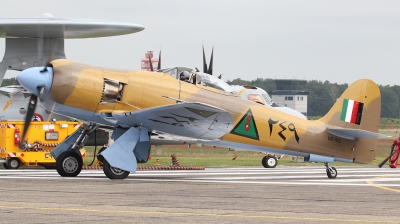
 Random great photos of the Hawker Fury ISS:
Random great photos of the Hawker Fury ISS:
